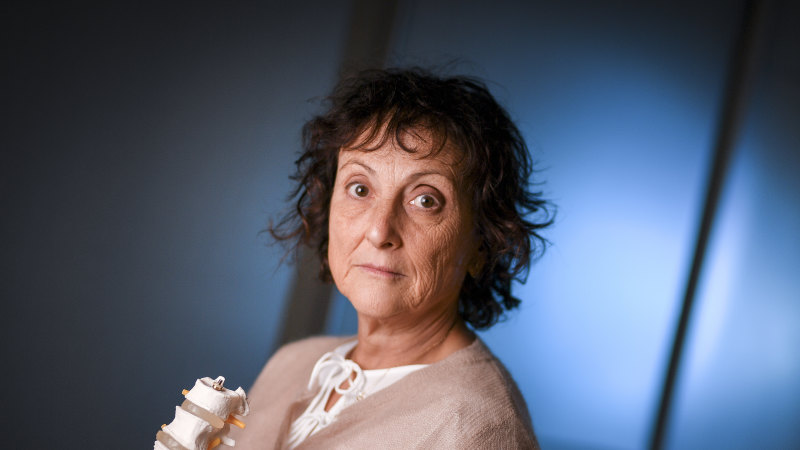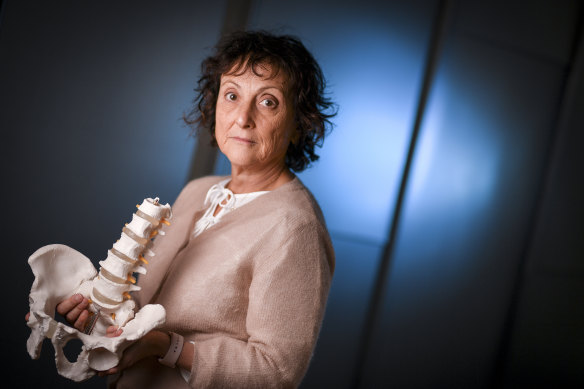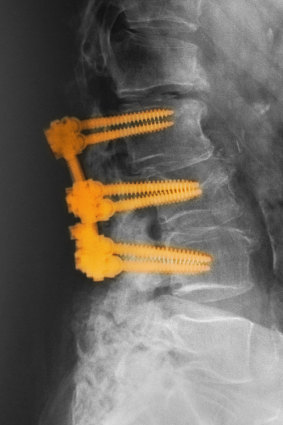Save articles for later
Add articles to your saved list and come back to them any time.
Examine, a free weekly newsletter covering science with a sceptical, evidence-based eye, is sent every Tuesday. You’re reading an excerpt – sign up to get the whole newsletter in your inbox.
Like many people who get chronic, crippling back pain, it came into Maree Rivero’s life by total surprise.
One day she was healthy, fit and full of life. The next day she was in pain. Her back ached for days, and then got better. And then ached again. And again.
Maree Rivero endured multiple operations for debilitating back pain. but nothing helped.
As the pain got worse, she felt her back begin to twist. The muscles would erupt into excruciating spasms. At age 34, she was told the discs that pad her spine had degenerated, and she would likely need surgery.
“It started almost like a bruise, and then as it got progressively worse it was like a heavy, hot, sharp pain, like a hot knife in your back,” says Rivero.
Rivero’s story is entirely common. Compared to cancer or COVID-19, back pain isn’t front of mind when we think of the things that make us sick. But back pain and back-related disability has grown into an epidemic.
As much as 84 per cent of the global population will suffer from back pain at some time in their lives. Every year in Australia, one in six of us will have back pain – almost 4 million people – and it will put more than 190,000 Australians in hospital.
Of all the ills that ail us, back pain robs more Australians of their healthy enjoyment of life than anything else.
But our back pain epidemic is quite unlike cancer or COVID because we seem to be doing it to ourselves.
“If we took away all the harmful treatment, minimised imaging and surgery when it’s not appropriate, injecting people, giving them crazy messages, we could halve the burden of back pain overnight,” says Professor Mark Hancock, a leading back pain researcher at Macquarie University.
The historical record does not suggest back pain troubled our ancestors to the same scale, despite long days spent in the fields.
Like obesity, back pain seems to be a disease of modern, Western society. After the reunification of Germany, back pain increased in formerly communist East Germany to match the higher levels seen in West Germany.
“You can see a rise in the burden of back pain in Indigenous cultures when they get exposed to Western medicine. It suddenly becomes a big medical problem,” says Professor Rachelle Buchbinder, lead author of a series of articles on back pain in The Lancet.
So, what’s gone wrong? We have learnt to fear our spines. We are constantly being told they are fragile – the discs sliding and degenerating. Our bad postures, weak cores, and days spent sitting on chairs doom us to a life of spinal failure.
Professor Rachelle Buchbinder, seen here in March 2018 at the launch of her Lancet series.Credit: Eddie Jim
These beliefs – none of which are supported by evidence – lead our brains to fret over any bit of pain we get in our backs. We don’t take a headache as a sign our brain is melting, yet back pain is often viewed as a coming crisis.
“The only difference is the location in which we experience it,” says Melbourne-based physiotherapist Luke Postlethwaite.
In fear, people have turned to a range of expensive treatments that either a) we don’t know work or b) we know don’t work. Chiropractors and ergonomists, injections and nerve burning, and some spinal surgeries. New treatments are invented faster than scientists can knock them down.
It is only now becoming apparent that expensive spinal cord stimulators may not work after hundreds of Australians have been injured by them.
Spinal fusion involves the joining of two or more vertebrae. Maree Rivero had a two-level spinal fusion after complications with her back operation.
Maree Rivero’s journey led her to epidural steroid injections – an extremely common first-line treatment for back pain. Evidence now suggests they don’t work, and may actually harm the discs. And like all operations, they come with a risk – albeit low – of side effects.
The needle nicked Rivero’s spinal column. Spinal fluid started leaking out. She lost pressure to her brain. “It was like being hit over the back of the head with a cricket bat. It was like that for a month,” she says.
She needed two more procedures to fix the damage from the first. And the pain was no better. Eventually, after one of her discs “exploded”, she had an operation to remove two spinal discs and join the vertebrae in their place. In hospital, she acquired an infection, requiring yet another operation.
For decades, back pain treatment has been like this, leaving scientists deeply disheartened. But in the past decade, that has started to change.
New discoveries in pain neuroscience have started to answer a key riddle: why people can have successful surgeries on “painful” parts of the spine but get no better.
Pain turns out to be complex and contextual. The actual damage in the tissue often has little bearing, which is why amputees still feel phantom pains.
We have come a long way from “it’s all in your head”. Science now puts brains at the centre of pain’s causes and cures.
And appropriate treatments are finally starting to follow.
Exercise has long been known to be useful, but is only a marginal help for people with chronic pain.
Two new treatments, pioneered by Australian scientists, focus on rebuilding the link between brain and back, trying to convince the brain the spine is not close to collapse, and to deprogram the pervasive “your-back-is-fragile” messaging.
And they work. One treatment, known as cognitive functional therapy, produced substantial decreases in pain and disability for those with chronic back pain. It is now rolling out across Australia.
As for Maree Rivero, she’s finally on the mend.
“If you don’t push through the pain and don’t do the rehab, you won’t get better,” she says. “It’s not just surgery alone that will fix you – so much of it lies with yourself.
“[People] think I’ll get an operation and be fixed, but nothing could be further from the truth.”
Back Up, Liam Mannix’s new book on back pain – and the new science offering hope – is out today. Click here to receive 19 per cent off the sale price.
Liam Mannix’s Examine newsletter explains and analyses science with a rigorous focus on the evidence. Sign up to get it each week.
Most Viewed in National
From our partners
Source: Read Full Article





